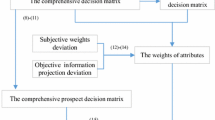Abstract
This paper proposed a novel multi-stage multi-attribute decision-making method, in which the period weights and attribute weights are completely unknown, and attribute values are triangular fuzzy numbers. At first, the triangular fuzzy prospect decision matrices of different periods are constructed and the period weights optimization model is built according to the time degree and the prospect value deviation of alternatives in different periods. The attribute weights are obtained by the maximum deviation method. Then, MULTIMOORA is extended into the triangular fuzzy environment. Based on the new form of MULTIMOORA and dominance theory, the final ranking of alternatives can be got. Finally, a numerical example is presented to illustrate the feasibility and effectiveness of the proposed method.

Similar content being viewed by others
Explore related subjects
Discover the latest articles, news and stories from top researchers in related subjects.References
Aggarwal Manish (2017) Adaptive linguistic weighted aggregation operators for multi-criteria decision making. Appl Soft Comput 58:690–699
Aydin Ö (2009) Bulanik AHPile Ankaraiç in hastaneyerseçimi. J Dokuz Eylul Univ Fac Econ Admin Sci 24(2):87–104
Balezentis AT, Balezentis WKM (2012) Personnel selection based on computing with words and fuzzy MULTIMOORA. Expert Syst Appl 39:7961–7967
Baležentis T, Zeng S (2013) Group multi-criteria decision making based upon interval-valued fuzzy numbers: an extension of the MULTIMOORA method. Expert Syst Appl 40:543–550
Brauers WKM, Baležentis MA (2011) MULTIMOORA for the EU member states updated with fuzzy number theory. Technol Econ Dev Econ 17:259–290
Brauers WKM, Zavadskas EK (2006) The MOORA method and its application to privatization in a transition economy. Control Cybern 35:445–469
Brauers WKM, Zavadskas EK (2010) Project management by MULTIMOORA as an instrument for transition economies. Technol Econ Dev Econ 16:5–24
Brauers WKM, Zavadskas EK (2011) MULTIMOORA optimization used to decide on a bank loan to buy property. Technol Econ Dev Econ 17:174–188
Brauers WKM, Zavadskas EK (2012) Robustness of MULTIMOORA: a method for multi-objective optimization. Informatica 23:1–25
Cao QW, Wu J (2011) The extended COWG operators and their application to multiple attributive group decision making problems with interval numbers. Appl Math Model 35:2075–2086
Chatterjee P, Chakraborty S (2012) Material selection using preferential ranking methods. Mater Des 35:384–393
Chen ZP, Yang W (2011) An MAGDM based on constrained FAHP and FTOPSIS and its application to supplier selection. Math Comput Model 54(11–12):2802–2815
Chu SJ (2011) Interactive group decision-making using a fuzzy linguistic approach for evaluating the flexibility in a supply chain. Eur J Oper Res 213(1):279–289
Datta S, Sahu N, Mahapatra S (2013) Robot selection based on grey-approach. Grey Syst 3:201–232
Dong M, Li S (2015) Approaches to group decision making with incomplete information based on power geometric operators and triangular fuzzy AHP. Expert Syst Appl 42:7846–7857
Hafezalkotob A, Hafezalkotob A (2015) Comprehensive MULTIMOORA method with target-based attributes and integrated significant coefficients for materials selection in biomedical applications. Mater Des 87:949–959
Huang ZL (2008) Method for triangular fuzzy number multiple attribute group decision making based on ideal solution. J Xiamen Univ 6:812–817
Jiang WQ (2015) Extension of VIKOR method for multi-criteria group decision making problems with triangular fuzzy numbers. Control Decis 30(6):1059–1064
Kahneman D, Tversky A (1979) Prospect theory: an analysis of decision under risk. Econometrica 47(2):263–292
Karande P, Chakraborty S (2012) Application of multi-objective optimization on the basis of ratio analysis (MOORA) method for materials selection. Mater Des 37:317–324
Kaufmann A, Gupta MM (1991) Introduction to fuzzy arithmetic: theory and application. Van Nostrand Reinhold, New York
Li C, Zeng S, Pan T, Zheng L (2014) A method based on induced aggregation operators and distance measures to multiple attribute decision making under 2-tuple linguistic environment. J Comput Syst Sci 80:1339–1349
Liu WS (2016) Research on preferred method of connection mining village based on AHP-TOPSIS of triangular fuzzy numbers. Appl Res Comput 33(2):458–462
Liu HC, Fan XJ, Li P (2014) Evaluating the risk of failure modes with extended MULTIMOORA method under fuzzy environment. Eng Appl Artif Intell 34:168–177
Merigo JM, Casanovas M (2011) Induced and uncertain heavy OWA operators. Comput Ind Eng 60:106–116
Pang JF, Liang JY, Song P (2017) An adaptive consensus method for multi-attribute group decision making under uncertain linguistic environment. Appl Soft Comput 58:339–353
Stanujkic D, Magdalinovic N, Jovanovic R, Stojanovic S (2012) An objective multi-criteria approach to optimization using MOORA method and interval grey numbers. Technol Econ Dev Econ 18:331–363
Tversky A, Kahneman D (1992) Advances in prospect theory: cumulative representation of uncertainty. J Risk Uncertain 5(4):297–323
Wei GW (2011) Grey relational analysis method for 2-tuple linguistic multiple attribute group decision making with incomplete weight information. Expert Syst Appl 38(5):4824–4828
Xu ZS (2004) Uncertain linguistic aggregation operators based approach to multiple attribute group decision making under uncertain linguistic environment. Inf Sci 168(1–4):171–184
Xu ZS (2011) Approaches to multiple attribute group decision making based on intuitionist fuzzy power aggregation operators. Knowl Based Syst 24(6):749–760
Yager RR (1988) On order weighted averaging aggregation operators in multi-criteria decision making. IEEE Trans Syst Man Cybern 18(1):183–190
Zhang HM (2016) Group decision making based on incomplete multiplicative and fuzzy preference relations. Appl Soft Comput 48:735–744
Acknowledgements
This study was funded by the National Science Foundation (Grant No. 91024029).
Author information
Authors and Affiliations
Corresponding author
Ethics declarations
Conflict of interest
All authors declare that they have no conflict of interest.
Ethical approval
This article does not contain any studies with human participants or animals performed by any of the authors.
Informed consent
Informed consent was obtained from all individual participants included in the study.
Additional information
Communicated by V. Loia.
Rights and permissions
About this article
Cite this article
Dai, Wf., Zhong, Qy. & Qi, Cz. Multi-stage multi-attribute decision-making method based on the prospect theory and triangular fuzzy MULTIMOORA. Soft Comput 24, 9429–9440 (2020). https://doi.org/10.1007/s00500-018-3017-0
Published:
Issue Date:
DOI: https://doi.org/10.1007/s00500-018-3017-0




